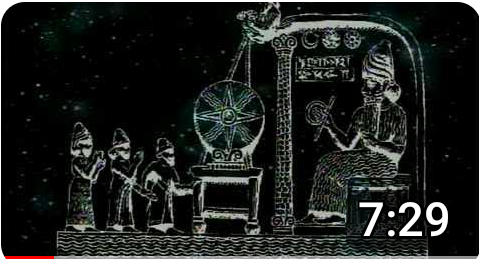When Saturn Ruled the World | From "Remembering the End of the World" 土星が世界を支配していたとき | 『世界の終わりの追憶』より
When Saturn Ruled the World | From "Remembering the End of the World"
土星が世界を支配していたとき | 『世界の終わりの追憶』より

https://youtu.be/11g9wj22J8I?si=vBMTihF_1UWxH0y9:embed
1
Introduction
The film clips that follow are from the documentary
"Remembering the End of the World," available at:
Introduction
以下のフィルムクリップは、ドキュメンタリーからのものです
「世界の終わりを思い出す」、以下で入手できます:
2
According to ancient Greek poets, philosophers and historians, the present age is just a shadow of the former epoch called the Golden Age of Kronos.
古代ギリシャの詩人、哲学者、歴史家によると、
現代はクロノスの黄金時代と呼ばれる、
かつての時代の影にすぎません。
3
But who was this ancient god Kronos?
しかし、この古代の神クロノスとは、
何者だったのでしょうか?
4
All Greek astronomical traditions agreed that Kronos was the planet Saturn.
すべてのギリシャの天文学の伝統は、
クロノスが土星であることに同意しました。
5
6
Our own name for the planets came from the Romans.
私たち自身の惑星の名前は、
ローマ人に由来します。
7
In unison Roman poets and historians insisted that in a former time Saturn had ruled as a god-king.
ローマの詩人や歴史家は一斉に、
かつては土星が、
神王として統治していたと主張した。
8
Producing a paradise on Earth.
地上に楽園を創り出す。
9
It would be almost impossible to overstate the power of this memory among the different cultures.
異なる文化の間で、この記憶の力を
誇張することはほとんど不可能です。
10
For the Babylonians, the Hebrews and the Greeks, the most sacred day of the week was the Sabbath, a ritual remembrance of the lost epoch.
バビロニア人、ヘブライ人、ギリシア人にとって、
一週間で最も神聖な日は安息日であり、
失われた時代を記念する儀式でした。
11
And in each of these cultures this holiest day was the day of Saturn.
そして、これらの文化のそれぞれにおいて、
この最も神聖な日は、土星の日であった。
12
The Latin is Saturni Dies or Saturn's day.
ラテン語では、土星の死、
または土星の日です。
13
The Celtic day of Cetur, our Saturday.
セトゥールのケルトの日、
私たちの土曜日。
14
[The Universal Monarch]
A worldwide tradition says that before a king ever ruled on Earth,
a prototype of Kings arose in heaven.
[宇宙の君主]
世界的な伝承によると、王が地球を支配する前は、
王の原型が天に現れた。
15
Father of Kings,
model of the good king.
王の父、
善き王のモデル。
16
[The universal monarch]
【宇宙の君主】
17
The Aztec Quetzalcoatl
アステカのケツァルコアトル
18
The Egyptian Ra
エジプトのラー
19
The Hindu Brahma
ヒンドゥー教のブラフマー
20
Every culture had its own Universal monarch.
すべての文化には、
独自の普遍的な君主がいました。
21
It is said that the local king is responsible for the prosperity of the nation.
地方の王は、
国家の繁栄に責任があると言われています。
22
In the reign of a good king, the Earth flowers abundantly.
Why is this?
良き王の治世には、
大地は豊かに花を咲かせる。
それはなぜか?
23
It is because the universal monarch, who set the standards of kingship,
brought forth a remarkable condition in primeval times,
an epoch called the Golden Age.
それは、王権の基準を定めた普遍的な君主が、
太古の時代に驚くべき状態をもたらした、
黄金時代と呼ばれる時代を。
24
[First Sun Guard]
Sunrise, to the star worshipers, a symbol of the cosmic dawn when the universal monarch, the first sun-god, shone above the world.
[ファーストサンガード]
星崇拝者にとっての日の出は、
宇宙の君主、最初の太陽神が、
世界を照らした宇宙の夜明けの象徴です。
25
The ancient Greeks called their sun-god, Helios.
We assumed they were referring to the Sun we know.
The Sun that rises in the east and sets in the west.
古代ギリシャ人は太陽神を、ヘリオスと呼んでいました。
私たちは、彼らが、私たちが知っている太陽のことを
言っているのだと思い込んでいました。
東から昇り、西に沈む太陽。
26
But in the earliest Greek manuscripts,
Helios was the name of the planet Saturn.
しかし、最古のギリシア語写本では、
ヘリオスは土星の名前でした。
27
And the Greeks were not alone.
The Babylonian Shamash, always translated as Sun, was identified as Saturn.
So also the Egyptian Ra,
the Hindu Surya,
the Latin Sol.
そして、ギリシャ人だけではありませんでした。
バビロニアのシャマシュは、
常に太陽と訳され、土星と同一視された。
エジプトのラーもまた、
ヒンドゥー教のスーリヤ、
ラテン語のソル。
28
But Saturn is a mere dot in a starry expanse.
しかし、土星は、
星々の広がりの中の点にすぎません。
29
What could have caused the first star worshippers to celebrate that minute speck as the Sun?
最初の星崇拝者たちが、その小さな斑点を、
太陽として祝ったのはなぜでしょうか?
30
[The Celestial Pole]
Every day our Sun rises in the east and sets in the west.
[天の極]
毎日、太陽は、
東から昇り、西に沈みます。
31
But the archaic sun-god Saturn did not rise or set.
It did not move.
しかし、古代の太陽神土星は、
昇ることも沈むこともなかった。
動かなかった。
32
Egyptian texts say of the sun-god Atum or Ra:
"The great God lives, fixed in the middle of the sky."
エジプトの文献には、太陽神アトゥム、または、
ラーについて次のように書かれています:
「偉大なる神は、空の真ん中に住んでおられる」
33
Surprisingly, the Babylonians used almost exactly the same language to describe the sun-god Shamash in the stationary center of heaven.
驚いたことに、バビロニア人は、
天の静止した中心にいる
太陽神シャマシュを説明するのに、
ほとんど同じ言語を使用しました。
34
For an Earth-bound observer, there's only one motionless spot in the sky,
the celestial pole.
地球に縛られた観測者にとって、
空には動かない場所が1つしかありません、
天の極。
35
The stars we see are actually cutting a circle around the polar axis close to the star Polaris.
私たちが見ている星は、実際には、
北極星に近い極軸の周りを、円を描いています。
36
Of course, nothing would seem more irrational than an ancient sun-god at this location.
もちろん、
この場所にいる古代の太陽神ほど、
不合理に思えるものはありません。
37
And yet, throughout the Near East, the universal monarch appears as a central Sun called the "Axis" and the "Pole of the World."
それなのに、中近東の至る所で、
普遍的な君主は、「枢軸」と「世界の極」
と呼ばれる中心の太陽として現れます。
38
To the Hindus, the sun-god Surya occupied the place of supreme rest, the motionless site.
ヒンドゥー教徒にとって、太陽神スーリヤは、
至高の休息の場所、動かない場所を占めていました。
39
So do the Greek Helios and the Aztec Quetzalcoatl.
ギリシャのヘリオスや、
アステカのケツァルコアトルもそうです。
40
In their earliest expressions, these figures occupy the stationary cosmic center.
これらの物は、
最も初期の表現において、
静止した宇宙の中心を占めている。
41
There is an astonishing unity to this global tradition.
この世界的な伝統には、
驚くべき一体性があります。
42
Ancient Iranian astronomers identified the pole as Saturn's home.
古代イランの天文学者は、
この極を、土星の故郷と特定しました。
43
And so did the Neoplatonist of Greece.
そして、ギリシャの、
ネオプラトン主義者もそうでした。
44
Roman poets remembered Saturn as the steadfast star.
ローマの詩人たちは、
土星を不動の星として記憶していました。
45
And chinese astronomers recalled that in the beginning, Saturn was the arch-premier at the celestial pole.
そして、中国の天文学者は、初めに土星が、
天の極のアーチプレミアであったことを思い出しました。
46
[The Great Crescent]
On every continent archaeologists have uncovered curious drawings of an archaic sun.
[グレートクレセント]
すべての大陸で、考古学者は、
古代の太陽の奇妙な絵を発見しました。
47
They do not look like our sun, yet they are strangely similar.
それらは私たちの太陽のようには見えません、
それなのに、不思議なほど似ています。
48
And most mysterious of all is the great crescent encircling the sphere of this enigmatic sun.
そして、何よりも神秘的なのは、
この謎めいた太陽の球体を取り囲む大きな三日月です。
49
Early Egyptian drawings place crescent horns on the sun-god Ra.
古代エジプトの素描では、
太陽神ラーに、三日月形の角が描かれています。
50
In Mesopotamia, the crescent is repeatedly drawn wrapped around the sun-god Shamash, a crescent Horn turning in the sky.
メソポタミアでは、三日月は、
太陽神シャマシュを包み込み、
三日月の角が空で回転する。
51
The image appears throughout the world, a vast crescent, unlike anything in our own sky today.
そのイメージは、
今日の私たちの空の、どのものとも違って、
広大な三日月形で世界中に現れます。